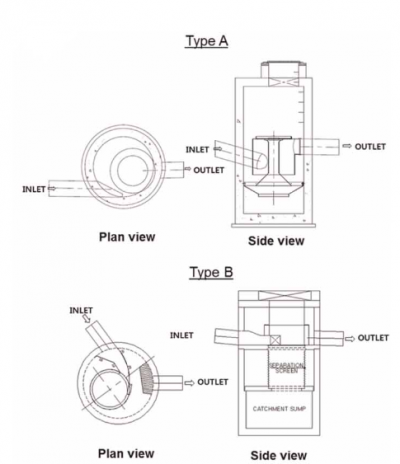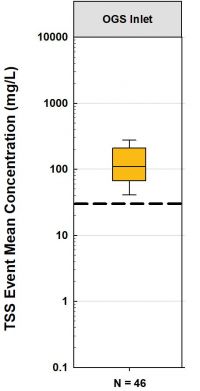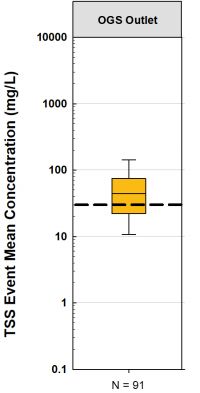Difference between revisions of "OGS: Performance"
| (4 intermediate revisions by the same user not shown) | |||
| Line 1: | Line 1: | ||
{{TOClimit| | {{TOClimit|3}} | ||
| Line 8: | Line 8: | ||
*Woodside SmartCentre (Markham) | *Woodside SmartCentre (Markham) | ||
*North Queen Street & The Queensway (Etobicoke) | *North Queen Street & The Queensway (Etobicoke) | ||
The mean performance value recorded at the inlet for OGS practices' ability to remove Total Suspended Sediments (TSS) was was calculated based on 46 separate recordings between 1997 - 1998 amongst the two sites previously mentioned. | The mean performance value recorded at the inlet for OGS practices' ability to remove Total Suspended Sediments (TSS) was was calculated based on 46 separate recordings between 1997 - 1998 amongst the two sites previously mentioned. | ||
| Line 23: | Line 22: | ||
*Woodside SmartCentre (Markham) | *Woodside SmartCentre (Markham) | ||
*North Queen Street & The Queensway (Etobicoke) | *North Queen Street & The Queensway (Etobicoke) | ||
The mean performance value recorded at the inlet for OGS practices' ability to remove Total Suspended Sediments (TSS) was was calculated based on 46 separate recordings between 1997 - 1998 amongst the two sites previously mentioned. | The mean performance value recorded at the inlet for OGS practices' ability to remove Total Suspended Sediments (TSS) was was calculated based on 46 separate recordings between 1997 - 1998 amongst the two sites previously mentioned. | ||
| Line 32: | Line 30: | ||
<br> | <br> | ||
'''Refer to the [[Oil and Grit Separator]] page for more information related to updated requirements through laboratory testing in accordance with the [https://etvcanada.ca/wp-content/uploads/2014/06/ETV-OGS-Procedure_final_revised-June_2014.pdf Procedure for Laboratory Testing of Oil-Grit Separators PDF (TRCA/CETV Program)] testing protocol and will have current and valid [https://etvcanada.ca/home/verify-your-technology/current-verified-technologies/ ISO14034: Environmental Technology Verification (ETV) program]. | '''Refer to the [[Oil and Grit Separator]] page for more information related to updated requirements through laboratory testing in accordance with the [https://etvcanada.ca/wp-content/uploads/2014/06/ETV-OGS-Procedure_final_revised-June_2014.pdf Procedure for Laboratory Testing of Oil-Grit Separators PDF (TRCA/CETV Program)] testing protocol and will have current and valid [https://etvcanada.ca/home/verify-your-technology/current-verified-technologies/ ISO14034: Environmental Technology Verification (ETV) program]. | ||
==Recent Performance Research== | ==Recent Performance Research== | ||
[[File:OGS types Lee, 2014 update.PNG|thumb|400px|Shown here are the two variations of hydrodynamic separators ([[Oil and grit separator]]s) used in the 6-year study conducted by Lee, et al., 2014. All four OGS' used were of different sizes. The first (Type A) was a dip cylindrical plate with a centershaft and the second (Type B) was a hollow cylindrical screen. All four sites where the OGS' were installed were in urban settings in Gyunggi Province, Korea, and discharge into Gyung-An stream, which deposits into the Pal-dang Lake. This lake is the the primary drinking water source for Seoul's Metropolitan area (Lee, et al. 2014<ref>Lee, D.H., Min, K.S. and Kang, J.H., 2014. Performance evaluation and a sizing method for hydrodynamic separators treating urban stormwater runoff. Water science and technology, 69(10), pp.2122-2131)</ref>.]] | |||
*[https://www.conteches.com/Portals/0/Documents/Product%20Evaluation%20and%20%20Testing/vx_harding_township.pdf?ver=2018-05-31-143332-863 (Greenway, 2001) - Stormwater Treatment Demonstration Project - Oil water/grit separator followed by a sand filter.] | *[https://www.conteches.com/Portals/0/Documents/Product%20Evaluation%20and%20%20Testing/vx_harding_township.pdf?ver=2018-05-31-143332-863 (Greenway, 2001) - Stormwater Treatment Demonstration Project - Oil water/grit separator followed by a sand filter.] | ||
**This project took place for Harding Township in New Jersey back in 2001. The performance assessment showcased the ability of a Vortechnics Oil/Grit separator followed by a sand filter's removal ability over three years located at a rest stop off a nearby highway. A full storm analysis was conducted over the three-year project and found that the average TSS (mg/L) entering the Oil/Grit separator was 492 mg/L whereas the outlet of the separator had only 35.18 mg/L of TSS remaining (a ~93% reduction rate). Once water passed through the sand filter after the OGS, the removal efficiency increased to 98.12%, with only 9.28 mg/L of TSS remaining (Greenway, 2001<ref>Greenway, R.A. 2001. Stormwater Treatment Demonstration Project—Oil water/grit separator followed by a sand filter: RTP Environmental Associates. Inc., prepared for Harding Township, NJ, Environmental Commission and the New Jersey Department of Environmental Protection, Paper WM-668. https://www.conteches.com/Portals/0/Documents/Product%20Evaluation%20and%20%20Testing/vx_harding_township.pdf?ver=2018-05-31-143332-863</ref>). | **This project took place for Harding Township in New Jersey back in 2001. The performance assessment showcased the ability of a Vortechnics Oil/Grit separator followed by a sand filter's removal ability over three years located at a rest stop off a nearby highway. A full storm analysis was conducted over the three-year project and found that the average TSS (mg/L) entering the Oil/Grit separator was 492 mg/L whereas the outlet of the separator had only 35.18 mg/L of TSS remaining (a ~93% reduction rate). Once water passed through the sand filter after the OGS, the removal efficiency increased to 98.12%, with only 9.28 mg/L of TSS remaining (Greenway, 2001<ref>Greenway, R.A. 2001. Stormwater Treatment Demonstration Project—Oil water/grit separator followed by a sand filter: RTP Environmental Associates. Inc., prepared for Harding Township, NJ, Environmental Commission and the New Jersey Department of Environmental Protection, Paper WM-668. https://www.conteches.com/Portals/0/Documents/Product%20Evaluation%20and%20%20Testing/vx_harding_township.pdf?ver=2018-05-31-143332-863</ref>). | ||
*[https://www.eeer.org/upload/eer-14-4-262-.pdf (Jianghua, et al. 2009) - Performance Analysis of a Hydrodynamic Separator for Treating Particulate Pollutants in Highway Rainfall Runoff.] | *[https://www.eeer.org/upload/eer-14-4-262-.pdf (Jianghua, et al. 2009) - Performance Analysis of a Hydrodynamic Separator for Treating Particulate Pollutants in Highway Rainfall Runoff.] | ||
** This study examined the separation characteristics of particles in runoff from paved roads using a OGS hydro cyclone design. The results indicated the TSS concentration ratio between the overflow and inflow (TSSover/in) decreased as a function of the operational pressure and the particle removal efficiency was mainly affected by the particle size. By using highway runoff results showed that removal efficiency was greater than 60%. The TSSover/in was (0.26 mg/L – 0.41 mg/L) below the Canadian Water Quality Guidelines (CWQGs) (Jianghua, et al. 2009<ref>Jianghua, Y., Qitao, Y. and Kim, Y. 2009. Performance analysis of a hydrodynamic separator for treating particulate pollutants in highway rainfall runoff. Environmental Engineering Research, 14(4), pp.262-269. https://www.eeer.org/upload/eer-14-4-262-.pdf</ref>). | ** This study examined the separation characteristics of particles in runoff from paved roads using a OGS hydro cyclone design. The results indicated the TSS concentration ratio between the overflow and inflow (TSSover/in) decreased as a function of the operational pressure and the particle removal efficiency was mainly affected by the particle size. By using highway runoff results showed that removal efficiency was greater than 60%. The TSSover/in was (0.26 mg/L – 0.41 mg/L) below the Canadian Water Quality Guidelines (CWQGs) (Jianghua, et al. 2009<ref>Jianghua, Y., Qitao, Y. and Kim, Y. 2009. Performance analysis of a hydrodynamic separator for treating particulate pollutants in highway rainfall runoff. Environmental Engineering Research, 14(4), pp.262-269. https://www.eeer.org/upload/eer-14-4-262-.pdf</ref>). | ||
*[https://pubmed.ncbi.nlm.nih.gov/24845330/ (Lee, et al. 2014) - Performance evaluation and a sizing method for hydrodynamic separators treating urban stormwater runoff.] | *[https://pubmed.ncbi.nlm.nih.gov/24845330/ (Lee, et al. 2014) - Performance evaluation and a sizing method for hydrodynamic separators treating urban stormwater runoff.] | ||
**This study conducted performance monitoring over a 6-year period (137 separate storm events) of four different hydrodynamic separators in Korean urban catchments between 2006 - 2012. Removal rates were relatively low at all four sites (1. Roadway site: Avg. Inflow = 239.32 mg/L vs Avg. Outflow = 122.2- mg/L / 2. Residential site: Avg. Inflow = 59.74 mg/L vs Avg. Outflow = 50.35 mg/L / 3. Roadway Site: Avg. Inflow = 62.50 mg/L vs. Avg. Outflow = 33.76 mg/L / 4. Residential(63.5%) & Roadway (36.5%) CDA site: Avg. Inflow = 236.24 mg/L vs. Avg. Outflow = 160.54 mg/L). The low removal rates were due to high rates of extreme overflow events occurring with most suspended sediment being quite small/fine in nature (<75μm)(Lee, et al. 2014<ref>Lee, D.H., Min, K.S. and Kang, J.H., 2014. Performance evaluation and a sizing method for hydrodynamic separators treating urban stormwater runoff. Water science and technology, 69(10), pp.2122-2131). | **This study conducted performance monitoring over a 6-year period (137 separate storm events) of four different hydrodynamic separators in Korean urban catchments between 2006 - 2012. Removal rates were relatively low at all four sites (1. Roadway site: Avg. Inflow = 239.32 mg/L vs Avg. Outflow = 122.2- mg/L / 2. Residential site: Avg. Inflow = 59.74 mg/L vs Avg. Outflow = 50.35 mg/L / 3. Roadway Site: Avg. Inflow = 62.50 mg/L vs. Avg. Outflow = 33.76 mg/L / 4. Residential(63.5%) & Roadway (36.5%) CDA site: Avg. Inflow = 236.24 mg/L vs. Avg. Outflow = 160.54 mg/L). The low removal rates were due to high rates of extreme overflow events occurring with most suspended sediment being quite small/fine in nature (<75μm)(Lee, et al. 2014<ref>Lee, D.H., Min, K.S. and Kang, J.H., 2014. Performance evaluation and a sizing method for hydrodynamic separators treating urban stormwater runoff. Water science and technology, 69(10), pp.2122-2131)</ref>. | ||
==References== | ==References== | ||
Latest revision as of 21:26, 3 March 2023
TSS Reduction[edit]
Inlet[edit]
The performance results for OGS practices, located within TRCA's watershed originate from three primary sites:
- Woodside SmartCentre (Markham)
- North Queen Street & The Queensway (Etobicoke)
The mean performance value recorded at the inlet for OGS practices' ability to remove Total Suspended Sediments (TSS) was was calculated based on 46 separate recordings between 1997 - 1998 amongst the two sites previously mentioned.
As can be seen in the corresponding boxplot the mean performance removal efficiency of the OGS practices monitored are well below the suggested guideline of 30 mg/L (Canadian Water Quality Guideline (CWQG), or (background (assumed at <5 mg/L)+ 25 mg/L for short term (<24 hour) exposure) (CCME, 2002[1]; (TRCA, 2021[2]).
The median value of the 46 samples taken was 109.50 mg/L whereas the mean was 145.07 mg/L, with a 96% guideline exceedance.
Outlet[edit]
The performance results for OGS practices, located within TRCA's watershed originate from three primary sites:
- Woodside SmartCentre (Markham)
- North Queen Street & The Queensway (Etobicoke)
The mean performance value recorded at the inlet for OGS practices' ability to remove Total Suspended Sediments (TSS) was was calculated based on 46 separate recordings between 1997 - 1998 amongst the two sites previously mentioned.
As can be seen in the corresponding boxplot the mean performance removal efficiency of the OGS practices monitored are well below the suggested guideline of 30 mg/L (Canadian Water Quality Guideline (CWQG), or (background (assumed at <5 mg/L)+ 25 mg/L for short term (<24 hour) exposure) (CCME, 2002[3]; (TRCA, 2021[4]).
The median value of the 91 samples taken was 44.50 mg/L whereas the mean was 64.60 mg/L, with a 61% guideline exceedance. Given the age of of these practices and the dates monitoring took place, these systems will likely need major maintenance and/or rehabilitation if not full replacement, as they near the end of their working lifecycle, especially given forthcoming Ontario guidelines on removal efficiencies, set to release later in 2023 (Low Impact Development Stormwater Management Guidance Manual). Read more about the performance efficiency of these specific OGS installations located within TRCA's watershed here, in the following document - Performance Assessment of Two Types of Oil & Grit Separator for SWM in Parking Lots (SWAMP, 2004[5]).
Refer to the Oil and Grit Separator page for more information related to updated requirements through laboratory testing in accordance with the Procedure for Laboratory Testing of Oil-Grit Separators PDF (TRCA/CETV Program) testing protocol and will have current and valid ISO14034: Environmental Technology Verification (ETV) program.
Recent Performance Research[edit]

- (Greenway, 2001) - Stormwater Treatment Demonstration Project - Oil water/grit separator followed by a sand filter.
- This project took place for Harding Township in New Jersey back in 2001. The performance assessment showcased the ability of a Vortechnics Oil/Grit separator followed by a sand filter's removal ability over three years located at a rest stop off a nearby highway. A full storm analysis was conducted over the three-year project and found that the average TSS (mg/L) entering the Oil/Grit separator was 492 mg/L whereas the outlet of the separator had only 35.18 mg/L of TSS remaining (a ~93% reduction rate). Once water passed through the sand filter after the OGS, the removal efficiency increased to 98.12%, with only 9.28 mg/L of TSS remaining (Greenway, 2001[7]).
- (Jianghua, et al. 2009) - Performance Analysis of a Hydrodynamic Separator for Treating Particulate Pollutants in Highway Rainfall Runoff.
- This study examined the separation characteristics of particles in runoff from paved roads using a OGS hydro cyclone design. The results indicated the TSS concentration ratio between the overflow and inflow (TSSover/in) decreased as a function of the operational pressure and the particle removal efficiency was mainly affected by the particle size. By using highway runoff results showed that removal efficiency was greater than 60%. The TSSover/in was (0.26 mg/L – 0.41 mg/L) below the Canadian Water Quality Guidelines (CWQGs) (Jianghua, et al. 2009[8]).
- (Lee, et al. 2014) - Performance evaluation and a sizing method for hydrodynamic separators treating urban stormwater runoff.
- This study conducted performance monitoring over a 6-year period (137 separate storm events) of four different hydrodynamic separators in Korean urban catchments between 2006 - 2012. Removal rates were relatively low at all four sites (1. Roadway site: Avg. Inflow = 239.32 mg/L vs Avg. Outflow = 122.2- mg/L / 2. Residential site: Avg. Inflow = 59.74 mg/L vs Avg. Outflow = 50.35 mg/L / 3. Roadway Site: Avg. Inflow = 62.50 mg/L vs. Avg. Outflow = 33.76 mg/L / 4. Residential(63.5%) & Roadway (36.5%) CDA site: Avg. Inflow = 236.24 mg/L vs. Avg. Outflow = 160.54 mg/L). The low removal rates were due to high rates of extreme overflow events occurring with most suspended sediment being quite small/fine in nature (<75μm)(Lee, et al. 2014[9].
References[edit]
- ↑ Canadian Council of Ministers of the Environment (CCME). 2002. Canadian water quality guidelines for the protection of aquatic life: Total particulate matter. In: Canadian Environmental Quality Guidelines, Canadian Council of Ministers of the Environment, Winnipeg
- ↑ TRCA. 2021. Spatial Patterns (2016-2020) and Temporal Trends (1966-2020) in Stream Water Quality across TRCA’s Jurisdiction Prepared by Watershed Planning and Ecosystem Science. https://trcaca.s3.ca-central-1.amazonaws.com/app/uploads/2021/10/29113334/2016-2020-SWQ-Report-v11_FINAL_AODA-FA.pdf
- ↑ Canadian Council of Ministers of the Environment (CCME). 2002. Canadian water quality guidelines for the protection of aquatic life: Total particulate matter. In: Canadian Environmental Quality Guidelines, Canadian Council of Ministers of the Environment, Winnipeg
- ↑ TRCA. 2021. Spatial Patterns (2016-2020) and Temporal Trends (1966-2020) in Stream Water Quality across TRCA’s Jurisdiction Prepared by Watershed Planning and Ecosystem Science. https://trcaca.s3.ca-central-1.amazonaws.com/app/uploads/2021/10/29113334/2016-2020-SWQ-Report-v11_FINAL_AODA-FA.pdf
- ↑ Stormwater Assessment Monitoring and Performance (SWAMP) Program. 2004. Performance Assessment of Two Types of Oil and Grit Separator for Stormwater Management in Parking Lot Applications – Markham & Toronto, Ontario. Report prepared for - Ontario Ministry of Environment, Toronto and Region Conservation Authority, Municipal Engineers Association of Ontario, and The City of Toronto. Published: July, 2004. Retrieved from: https://sustainabletechnologies.ca/app/uploads/2013/03/OGS_entire-report.pdf
- ↑ Lee, D.H., Min, K.S. and Kang, J.H., 2014. Performance evaluation and a sizing method for hydrodynamic separators treating urban stormwater runoff. Water science and technology, 69(10), pp.2122-2131)
- ↑ Greenway, R.A. 2001. Stormwater Treatment Demonstration Project—Oil water/grit separator followed by a sand filter: RTP Environmental Associates. Inc., prepared for Harding Township, NJ, Environmental Commission and the New Jersey Department of Environmental Protection, Paper WM-668. https://www.conteches.com/Portals/0/Documents/Product%20Evaluation%20and%20%20Testing/vx_harding_township.pdf?ver=2018-05-31-143332-863
- ↑ Jianghua, Y., Qitao, Y. and Kim, Y. 2009. Performance analysis of a hydrodynamic separator for treating particulate pollutants in highway rainfall runoff. Environmental Engineering Research, 14(4), pp.262-269. https://www.eeer.org/upload/eer-14-4-262-.pdf
- ↑ Lee, D.H., Min, K.S. and Kang, J.H., 2014. Performance evaluation and a sizing method for hydrodynamic separators treating urban stormwater runoff. Water science and technology, 69(10), pp.2122-2131)

